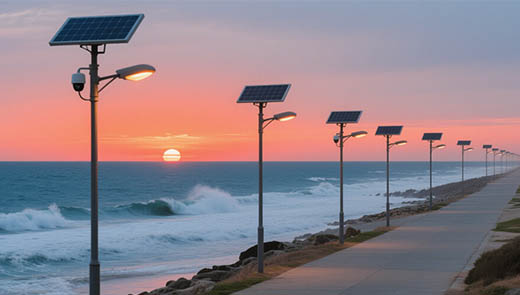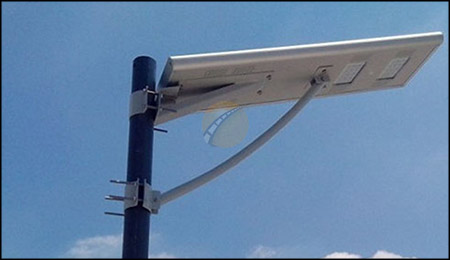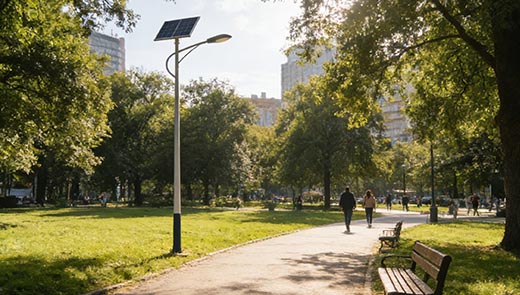Solar street lights: maintenance guide for sandstorm weather
As an environmentally friendly, energy-saving lighting device, solar street lights play an important role in a variety of environments such as city roads, countryside trails, parks and scenic spots. It relies on solar power to generate electricity without the need to lay complicated wires, which saves energy and reduces pollution to the environment. However, the normal operation of solar street lights can be seriously affected in sandstorm weather. The large amount of sand and dust brought by sandstorms will adhere to the various components of the street light, leading to a decline in its performance and even shortening its service life. Therefore, a solar street light maintenance guide for sandstorm weather is especially important.
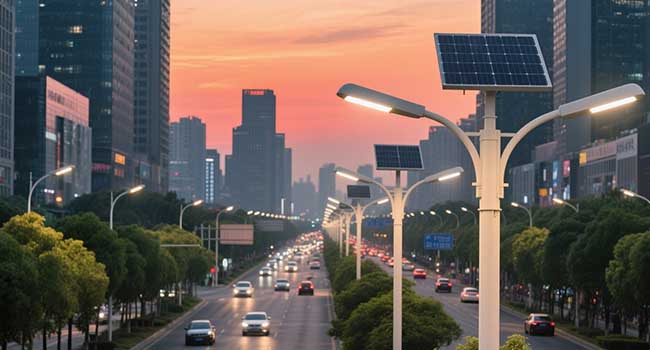
How does sand accumulation affect solar LED street lighting performance?
Impact on photovoltaic panel efficiency
Sand and dust accumulation on the Sand buildup on solar PV panels significantly reduces their energy conversion efficiency. Even a thin layer of sand particles can block up to 25% of the sunlight from reaching the photovoltaic cells, significantly reducing the amount of power generated. These tiny particles form a barrier that prevents the PV panels from optimally absorbing light, forcing the entire system to rely more on battery reserve power. This reduction in charging efficiency means that solar streetlights may operate at lower levels of brightness at night, or for shorter lighting times.
To make matters worse, the buildup of sand and dust can also create hot spots that can cause permanent damage to individual solar cells in a PV panel array. Therefore, regular monitoring of PV panel surface conditions is critical to maintaining optimal performance.
Battery pperformance under sand-laden conditions
In sandy weather, when the PV panels are covered with sand and dust and are unable to generate enough power, the batteries have to compensate for this by providing a longer supply of power, which results in longer discharge cycles than originally designed, thus creating an additional burden on the solar street light's battery system under additional stress.
This extra workload accelerates the aging of the batteries and shortens the service life of the entire system. In addition, sand and dust infiltration into the battery compartment can lead to corrosion problems and electrical connection failures. In the harsh desert environments where solar streetlights operate, proper sealing and ventilation systems are essential to protect the battery components and maintain optimal operating temperatures.
LED module degradation from abrasive particles
LED components in solar street lights face unique challenges during sandstorms due to exposure to abrasive particles and thermal stress. Dust particles carried by strong winds can scratch protective lens covers, reducing light transmission efficiency and causing surface irregularities that affect beam patterns. In addition, the combination of sand and dust buildup and heat generation can cause thermal stress on the LED junction temperature, potentially shortening the life of the lighting module. In solar street light applications, protective housings and proper ventilation design play a critical role in maintaining LED performance standards when exposed to sandy environments for extended periods of time.
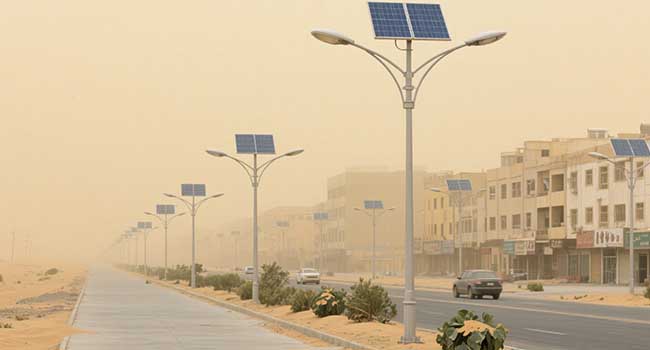
Steps to maintain solar street lights in sandstorm weather
Regularly clean solar panels
After a sandstorm, clean the sand and dust from the solar panels. When cleaning, use a clean, soft cloth or sponge to gently wipe the surface of the panels to avoid scratching or damaging them.
Do a good job in sealing the lighting fixtures
When using solar street lights, make sure that the housings and interfaces of each luminaire are well sealed to prevent sand and dust from entering the interior of the luminaire. You can use waterproof tape or glue for sealing treatment to improve the dustproof performance of the lighting fixtures.
Check if the circuit connections are loose
Strong winds during sandstorms may cause the circuit connections of solar street lights to loosen, affecting their normal use. It is important to check the circuit connections regularly to ensure that the contact between the components is good, firm and reliable.
Prevention of static electricity issues
Sandstorms are prone to static electricity which may cause damage to electronic equipment. When maintaining solar street lights, pay attention to avoid static electricity, use anti-static gloves or tools to operate.
Pay attention to safety protection
When cleaning and maintaining solar street lights, be sure to pay attention to safety protection measures. Wear gloves, masks, goggles and other protective equipment to ensure personal safety.
Regular inspection and maintenance
Regularly check the indicators of the solar street light, such as the battery capacity, the sensitivity of the light controller and sensors. If abnormalities are found, repair or replace the parts in time.
|
Inspection Item |
Inspection Content |
Handling Method |
|
Battery Capacity |
Measure whether the actual battery capacity is within the normal range |
Replace the battery promptly if the capacity is insufficient |
|
Light Controller Sensitivity |
Test whether the light controller responds sensitively to changes in light |
Repair or replace the light controller if sensitivity is abnormal |
|
Sensor Sensitivity |
Check whether the sensor accurately detects environmental factors (e.g., light, wind) |
Repair or replace the sensor if detection is inaccurate |
Adjusting the lighting angle
According to the characteristics of the sandstorm weather, the lighting angle of the solar street light can be adjusted appropriately to improve the lighting effect. For example, the lighting angle can be appropriately adjusted downward to reduce the blocking of light by sand and dust.
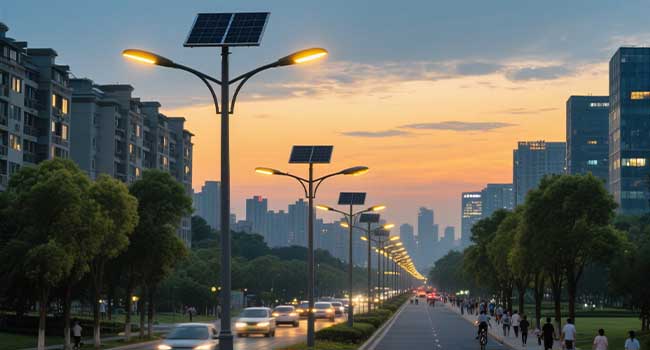
Recommendations for selecting solar street lights in areas prone to sandstorms
In order to reduce the damage of sand and dust storms on solar street lights from the source, prolong the life of the equipment and ensure the stability, it is necessary to combine the special characteristics of sand and dust environments when selecting solar street lights, and pay targeted attention to the following core elements:
Reinforcement of the enclosure and the level of protection
Priority to the selection of the products with a level of protection of IP66 and above (IP66 can completely prevent dust intrusion and withstand the impacts of dust). (IP66 rating can completely prevent dust intrusion, and can withstand strong water spray). Shell material is recommended to use corrosion-resistant aluminum alloy or stainless steel, the surface of sandblasting, anodic oxidation and other special treatments to enhance the ability to resist sand abrasion and rust. At the same time, the seams of the lamps need to be sealed with silicone seals to avoid sand and dust entering the interior through the seams.
Anti-sand and dust design of PV panels
The surface of the PV panels should be made of ultra-white tempered glass, with a thickness of no less than 3.2mm, and with anti-reflective coatings (AR coatings) and abrasion-resistant treatments - the anti-reflective coatings reduce the adhesion of sand and dust, and the abrasion-resistant treatments reduce the damage caused by the scratches of wind and sand particles. In addition, choose PV panels that are “self-cleaning” (e.g., with a nano-coating on the surface that utilizes rain or dew to reduce sand and dust residue), or panels with a better tilt angle design (a tilt angle of 30°-45° is usually recommended to use gravity to assist in the sliding off of sand and dust).
Battery adaptation selection
Batteries need to be resistant to high temperatures, corrosion, and sealing. It is recommended to use deep-cycle gel batteries or lithium batteries: the electrolyte of the gel battery is gelatinous, not easy to leak, and can resist the corrosion of the electrodes of the sand and dust; lithium batteries are small in size, good sealing and better low-temperature performance, suitable for sand and dust areas with a large difference in temperature between day and night. At the same time, the battery compartment should be designed as a sealed, with a breathable valve, and away from the heat dissipation area of the LED light source, to avoid high temperature accelerated battery aging.
Optimization of LED module protection
The lens of the LED luminaire should be made of high-transmittance polycarbonate (PC) and hardened to reduce the loss of light transmission caused by wind and sand scratches. Lamps and lanterns should be equipped with internal dust net, blocking the entry of fine sand and dust; cooling structure needs to be designed as a “labyrinth”, not only to ensure air circulation and heat dissipation, but also to prevent sand and dust invasion of LED chips. In addition, choose a wide voltage input LED driver to adapt to the unstable situation of photovoltaic panel power generation under sandy and dusty weather.
Structural stability and accessory adaptation
The light pole should be made of high-strength steel, and the size of the flange at the bottom should be enlarged to ensure that it will not fall down in the strong wind and sand. The bracket connecting the photovoltaic panels and lamps should adopt anti-loosening design (e.g. using anti-loosening nuts and spring washers) to avoid the parts falling off due to wind and sand vibration. Sensors (such as light control, infrared sensors) should be selected dust-proof type, the probe surface covered with a dust cover to prevent sand and dust cover affecting the sensitivity.
In sandstorm-prone areas, the maintenance and reasonable selection of solar street lights is the key to ensure its long-term stable operation. Through targeted daily cleaning, sealing protection, circuit inspection, static electricity prevention and other maintenance work, combined with the selection of equipment with high protection level and dust-resistant design, it can effectively reduce the damage of sandstorms on the components of the solar street light, extend its service life and ensure the lighting effect. Only by combining scientific maintenance measures with appropriate equipment selection can solar streetlights continue to play an environmentally friendly and energy-saving advantages in the harsh sand and dust environment and provide reliable lighting support for various places.

